
The TI-99/4a, Ken Gilliland and Notung Software
Start with the TI-99/4a
I started my computing life with a TI-99/4a in 1981, the year it was introduced. What sold me on the TI-99/4a was the speech synthesizer which a TI Representative was demoing at a local department store. The TI-99/a was an expensive piece of machinery back then-- I think I paid $350-400 for the console and another $100 for the speech synthesizer. After a week of playing around, programming and composing digital music, I returned to the store and purchased the tape cassette recorder so I could actually save my programs on tape. The Rep remembered me but seemed unconvinced that within a week I could have already mastered TI-Basic. I returned days later with my cassette tape of programs and showed him, thus starting my computing life as a programmer.
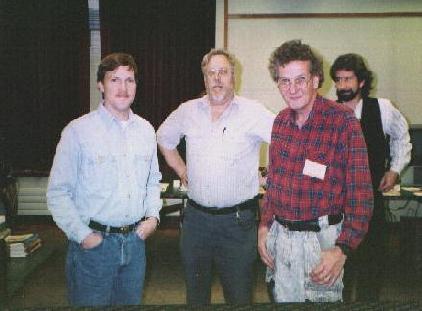
For the first several years I did music programs with graphics. My first online service was "The Source" and I won first prize in a programming contest on it for my graphical music program "Siegfried's Funeral Music" (by composer Richard Wagner) in 1983. For those who don't know, the "Source" eventually merged into CompuServe which eventually turned into AOL with the birth of the internet. I also ventured into the BBS (bulletin board system) world long before the days of the internet (I want to say around 1984) with a Cal-Tex BBS system. The "KBGB BBS" ran for about 3 years and featured TE-2 16-color for TI systems that logged on as well as text graphics, online games and a message forum for all users. Online games ranged from a Beatles trivia multiple choice quiz to a role-playing Old West reenactment.
In the heyday of my BBS, I was introduced to TI-99 user groups and started a membership in the San Fernando Valley 99ers. I began assembling the many music-graphic programs I had written and started to create shareware disks. The most popular of these was the text graphic images of my BBS's monthly "Girlie Calendar"
I owe a debt of gratitude to Jim Peterson, after studying many of his programs I learned how to expand the TI’s musical octave range and added voice to my music programs. This started my series of “singing” disks which included musical and song from musicals such as South Pacific, the Music Man and Wizard of OZ. I cringe at the thought of hearing the TI sing through Patsy Cline’s hits, but yes, I take full responsibility for that horror, too.
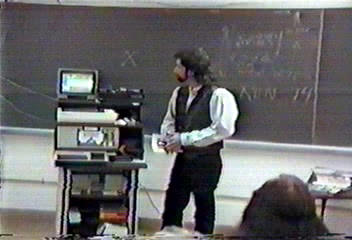
The Asgard Years
Its funny how one perceives things, I always assume my shareware music disks were popular for their music but I soon discovered that it was the graphics and animation that really caught people’s attention. I found this to be true after Asgard Software contacted me about making clipart for the popular TI-Artist program. I started by creating a typefaces. One doesn’t think too much about typefaces now with the huge array of TTF and PFM fonts, but back then there wasn’t anything available.
With the Tunnels of Doom Editor being released I started creating hybrid adventures on my “still” favorite TI-99 game. Asgard ended up marketing some of these as well in their Doom game collections. My first solo commercial release was “Disk of Dinosaurs” which started the “Disk of” series. The “Disk of” series in many ways was a forerunner to what companies would eventually called “multimedia”. They were theme-based packages which consisted of images/clipart, music, educational text materials and in later volumes, a game. My last release through Asgard was “Disk of Pyrates”. After that release, I decided I wanted more control over how my products were packaged and markets and of course there was only one way to do that… form your own company.
Notung Software
Since I had come from a Nordic sounding company (Asgard) it seemed appropriate that I stuck with the theme. “Notung” (the name of Siegmund and Siefried’s sword), seemed like a good choice. Notung translated into English means “needful” (which I was at the time) and the logo concept of a sword through the diskette cemented my choice in company names. I threw together what projects and shareware programs I hadn’t released and long-time friend, Ray Kazmer, joined in under the Notung banner and my company was up and running at the start of 1990.
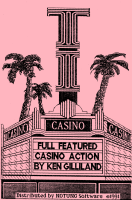 I released more of “Disk
of” series (Son of Disk of Dinosaurs, Bride of Disk of Dinosaurs,
Disk of Horrors”) and started my own typeface collection with “Fonts and
Borders” to moderate success.
I released more of “Disk
of” series (Son of Disk of Dinosaurs, Bride of Disk of Dinosaurs,
Disk of Horrors”) and started my own typeface collection with “Fonts and
Borders” to moderate success.
TI Casino
I gave my father a TI-99/4a for Christmas along with many of the better gambling game programs on disk. While he liked the present , he complained that the games were too confusing; he couldn’t keep track of what key presses worked with what games and there was no way to pass your winnings from one game to the next. After looking at the programs, I decided it would be less work to start from scratch than fix the existing games—and that’s how TI Casino was born. I'm guessing I have some bragging rights in that TI Casino was the first “casino” (multiple gaming tables) based game I’m aware of on any computer. TI Casino was clearly Notung Software’s break-through product and became my best selling TI-99 product of all time.
A year later, I released “TI Casino Supplement” which cleans up some minor bugs and added more games and features to the Casino Disk.
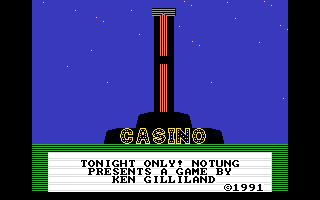
I had written some Printer’s Apprentice tutorials in the late 80’s, and ever since then have had numerous requests for reprints of them. Printer’s Apprentice was a great desktop publishing program with a very difficult to understand manual. I decided to branch out and write a softcover book using the existing tutorials I had written and adding several more new chapters. This project began known as “How to Use the Printer’s Apprentice (and not go insane)”. To this day, I still get an occasional request for that book. Around the time of the release of the book, I received an honorary "Pagemanship Award" from the program's creator.
Finally, the “Disk of” series gained popularity with the release of “Old West”, “Ancient Ones” and “Medieval Times”. These three disks I consider to be some of my best TI work. "Disk of the Ancient Ones" included a first person 3-D maze game that predated many of the PC popular 3D shooters.
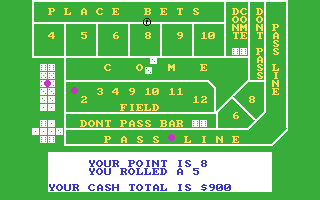
The Later Years
I returned briefly to my music roots when Midi Master allowed the TI-99/4a to hook-up to a Midi keyboard. I also experimented with the Geneve 9640 and writing in the “C” language for it. I signed Darin Andrade, a up and coming Geneve programmer to Notung and he produced a series of really good 9640 games.
As TI Faires began to close and sales began to wane, I renewed my interest in oil painting. In 1993, the Orlando Gallery in Los Angeles, decided to represent me. For my remaining “TI-99” years I focused mostly on oil painting and did little programming. This paid-off in 1995 with a Gallery Show at the Orlando.
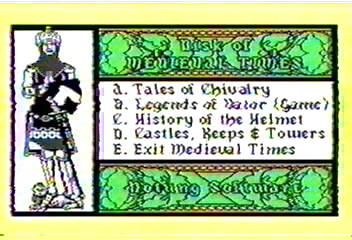
In 1996, with the dissolution of MS Express Software, Notung picked up Mickey Schmidt-Cendrowski and Norman Rokke as authors.
The last Notung Product was released in 1996—an add-on for TI Casino called “Casino Solitaire”. It was programmed on the V9T9 TI emulator.
Notung Software continued its mail-order catalog until 2000, when it finally close it’s doors. I became interest in 2D and 3D art on the PC in the later 1990's and began creating digital content for 3D software applications such as Poser professionally with the close of Notung.
In 2011, I was honored to be inducted in the TI Hall of Fame.
Chronology
Complete Software List- 1981
- Ken Gets a TI-99/4a computer
- 1983
- MAR: Microsoft Multiplan for the TI-99/4a is released
- OCT: TI abandons it's home computer and opens software development to 3rd party programmers
- Ken wins first place in a programming contest on the "Source"
-
1984
- Ken starts to build a reputation as a music and graphics programmer
- Ken opens a TI-99/4a BBS -- the first TI run BBS in Southern California
- 1985
- Numerous "Shareware" disk start to appear including the infamous "Girlie Calendar"
- 1986
- MAR: The San Fernando Valley 99ers User Group is born when they are apparently "cast out" of the parent LA 99ers User Group. First president of the new SFV 99ers is Ken Gilliland.
- 1987
- OCT: Asgard Software's Artist Fonts Volume 1 released.
- 1988
- Disk of Dinosaurs released through Asgard
- 1989
- JUN: CompuServe purchases "The Source"
- AUG: Disk of Pyrates released through Asgard
- OCT: McCann Software presents its 1989 Pagemanship award to Ken Gilliland for his excellent tutorials on use of The Printer's Apprentice.
- NOV: Doom Games 3 released by Asgard
- 1990
- Doom Games 4 released by Asgard
- Certificate99 Companion Plus is released by Asgard
- Fonts & Borders is released
- Notung Software is born. Noted programmer and friend of Ken's, Ray Kazmer, decides to publish under Notung
- All previously published Asgard titles plus Baba Brewery, Ring Companion are released by Notung
- Fonts & Borders II is released
- Son of the Disk of Dinosaurs is released
- 1991
- Bride of the Disk of Dinosaurs is released
- Fonts & Borders III is released
- Fonts & Borders IV is released
- JUN: TI Casino v1.0 and Kazmer's Star Trek: Next Generation Calendar are released
- JUL: Midi Master Songs Volume 1 is released for MIDI Master 99
- SEP: Midi Master Songs Volume 2 is released
- NOV: Disk of Horrors is released
- 1992
- JAN: TI-Casino v3.3 released
- APR: Disk of the Old West is released
- Fonts & Borders V is released
- Darin Andrade signs with Notung and publishes Wingquest and Armor Ambush
- Disk of the Anicent Ones is released
- Disk of the Medieval is released
- The book "How to use the Printer's Apprentice" is published
- SEP: Midi Master Songs Volume 3, 4 & 5 are released
- 1993
- Ken focuses on oil painting and gallery shows, doing less programming
- Fonts & Borders VI is released
- Fonts & Borders VII is released
- 1994
- Mickey (Schmitt) Cendrowski and Norm Rokke move their catalogs to Notung
- 1995
- 1996
- NOV: Casino Solitaire released at the Chicago TI-Faire
- 1997
- 1998
- Emperor Ken's World goes online via the World Wide Web
- 1998
- 1999
- 2000
- Notung Software ceases business
- Ken begins to focus on 3D art and selling through Vista Internet Products
- 2001
- Ken's Frog set is about to be published by Zygote software when they suddenly drop all Poser publishing
- Ken opens a store at Renderosity and releases models based on Edward Hopper's paintings "Early Sunday Morning" and "Nighthawks"
- 2002
- ex-Zygote's Poser divison becomes DAZ 3D and Ken signs with them
- Fashions of the Old West is released through DAZ3D
- 2003
- Songbird ReMix, Songbird ReMix Characters and Woodpeckers are released
- 2004
- Songbird ReMix Threatened, Endangered, Extinct is released which changes Ken's direction and pushes conservation themes in his work from then on
-
2011
- Ken Gilliland inducted into the TI-99/4a Hall of Fame